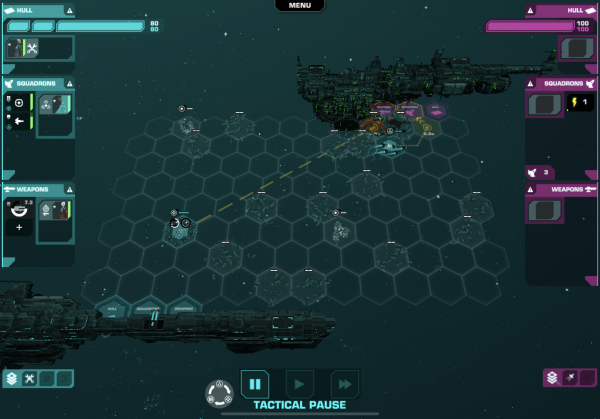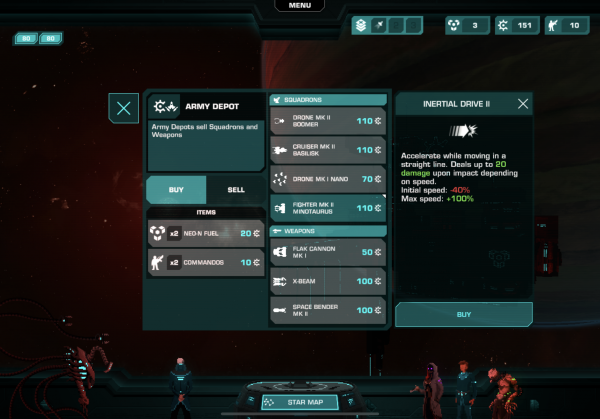The empire has fallen. The infrastructure that held up an intergalactic civilization shut down overnight, and everyone in the universe is now isolated and suffering. The only person who can save them is you, but who are you really, and what does saving the universe mean? This is the setup for Crying Suns, a game that iterates primarily on the gameplay formula of FTL by weaving a ton of lore into a chapter-based run system. It's a game that is both systemically and narratively rich in a way that satisfies each and every time you play it.

Contingency clones
In Crying Suns, you play as admiral Ellys Idaho, the greatest fleet commander in the empire's history, or at least... sort of. The game quickly reveals in its intro that you're actually a clone of Idaho, and one of many, for that matter. Your cloned selves are actually part of a contingency plan for the empire. In its vast expansion across space, society had grown increasingly dependent on all sorts of technology for survival. If any of it failed, you were to be awoken in an effort to restore balance and order to the universe.
The game begins 20 years into utter societal collapse. A sudden shutdown of all artificial intelligence networks has isolated every galaxy from one another, leaving everyone unprepared to fend for themselves. Only you, your crew, and the only non-networked AI designed to aid you have the ability to leap between galaxies in an effort to find out what happened and restore some semblance of stability to the galaxies you pass through along the way.
Space-time loop
Crying Suns lays out this setup through a lengthy exposition, but then continues to further build out its world and lore as you play through it. The structure of the game should be pretty familiar if you've played FTL, Subset Games's breakout hit where players command their own starship as they jump from sector to sector on a run for survival, or any number of games that have taken inspiration from it since its debut back in 2012.
There are quite a few things that Crying Suns does to differentiate itself among contemporaries in this space. In addition to managing your battleship, combat involves direct control of a fleet of smaller units in hex-based, real-time conflicts. There is also a system for scavenging resources by exploring planetary surfaces, though it's mostly just a push-your-luck guessing game than anything you have direct control over. What really makes Crying Suns feel special though is its narrative, which--in addition to adding texture to every place you travel to--evolves each time you complete a run.
Cosmic clunkiness
Crying Suns is divided into five chapters that change the sector of space you're exploring and the enemies you're facing after each successful run. There isn't a whole lot done to mix up the random events you come across, but each chapter does hold unique boss archetypes and new narrative developments that clue you in to what caused the mass shutdown, as well as who is behind it. As you play, you also unlock new starting ships and crew members that allow for different strategic possiblities across each playthrough. If you ever die on a run, the fact that you're a clone justifies why you might be journeying through the same sectors asking the same questions between each run, which is a clever touch.
I find nearly every aspect of Crying Suns an innovation or advancement of the groundwork laid by FTL. That said, there are some quirks to the UI in Crying Suns that are cause for some concern. Specifically, there's inconsistency in tapping and holding commands. In some situations, this input reveals more information, and in others, it confirms a choice. I definitely had a few early runs enter death spirals specifically because I made choices I didn't intend to, but by the end of the first chapter this ceased to be a concern.
The bottom line
Crying Suns puts more than a simple twist on a tried-and-true formula. It combines multi-faceted systems with a unique narrative structure in ways that breathe new life and mystery into something that initially appears derivative. Despite a few UI quirks, Crying Suns is a refreshing sci-fi roguelite experience, and the mobile port features the modern conveniences (like save syncing) you'd want for on-the-go play.
PocketGamer.com
AppSpy.com
148Apps.com
PocketGamer.fr
PocketGamer.biz
PCGamesInsider.biz
The Sims News
PocketGamer.fun
BlockchainGamer.biz
PG Connects
BigIndiePitch.com
MobileGamesAwards.com
 U.GG
U.GG
 Icy Veins
Icy Veins
The Sims Resource
Fantasy Football Scout
GameKnot
Addicting Games
 Arcade Cloud
Arcade Cloud
 Wisecrack
Wisecrack
 EV.IO
EV.IO
Luminosity



